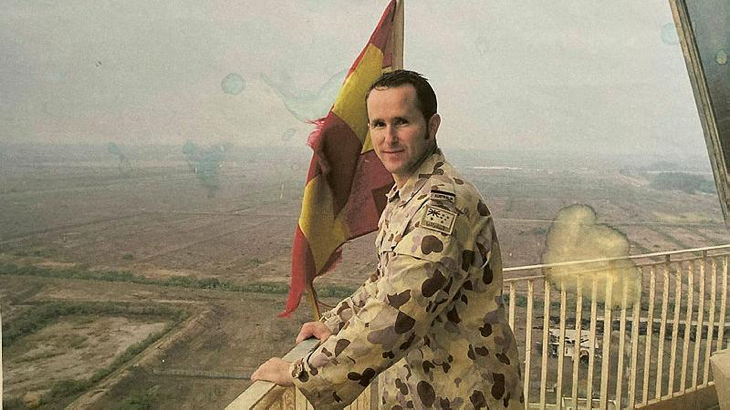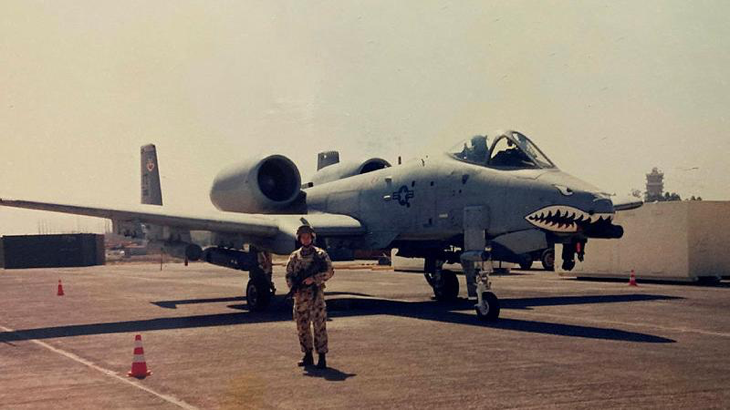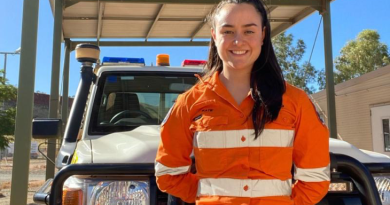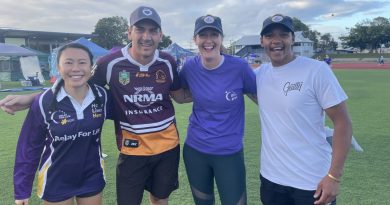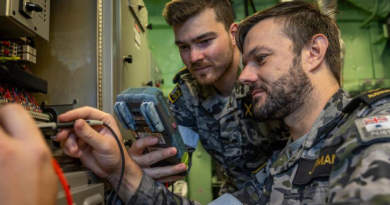Tall and proud in the control tower

Air Traffic Controllers often have to deal with the unexpected. This is especially true in war zones.
CAPTION: Squadron Leader Peter O’Connell in Baghdad, where he was part of the first Coalition rotation to the city’s airport air traffic control tower. Story by Sergeant Matthew Bickerton.
It’s a lesson Squadron Leader Peter O’Connell quickly learned while deployed to Iraq in 2003 as a junior air traffic controller.
After Saddam Hussein’s regime was toppled that year and the Iraqi Army was disbanded, a formidable insurgency grew from the shadows.
Squadron Leader O’Connell was part of the first Coalition rotation to Baghdad Airport’s air traffic control tower.
“When I got there, the insurgents started coming out and campaigning against Coalition forces,” Squadron Leader O’Connell said.
“We were on the airfield, right in the thick of it.”
CAPTION: Squadron Leader Peter O’Connell with an A-10 Warthog in Baghdad.
Squadron Leader O’Connell remembered a Coalition C-17 Globemaster coming in to land performing an ‘initial and pitch’.
This manoeuvre is used when landing to reduce time at low altitudes where aircraft are vulnerable to ground attack. It’s typically used by fast jets and not heavy transport aircraft.
“We told the aircraft to pitch left,” Squadron Leader O’Connell said.
Just as it went to pitch left, somewhere outside the airfield was an insurgent with a rocket launcher. The pilot turned right to avoid the attack.
“Imagine something that size making a turn you weren’t expecting,” Squadron Leader O’Connell said.
During the same deployment, Squadron Leader O’Connell saw a DHL (civilian) cargo plane crash-land after being struck by a surface-to-air missile.
“It didn’t explode in air, but it was crashing. It crash landed onto the runway and skidded off. The pilot did an amazing job,” he said.
The incident was featured on the television show Air Crash Investigation.
Squadron Leader O’Connell was the most junior air traffic controller on that rotation, having only been qualified for a year.
“Going to Iraq, having that exposure and controlling like we did, absolutely expedited my abilities as a controller and an officer,” he said.
After 30 years in Air Force, Squadron Leader O’Connell will hang up his uniform in August.
He joined in 1992 and spent his first eight years as an air surveillance operator, before commissioning and becoming an air traffic controller in 2002.
“I looked at air traffic control towers and was always curious about what they did in there. It seemed like witchcraft,” Squadron Leader O’Connell said.
At the time, civilians did the course in 18 months, whereas the Air Force did it in nine.
“It was quite a difficult course to be honest,” Squadron Leader O’Connell said.
His youngest brother, Flight Lieutenant Brody O’Connell, followed in his footsteps.
Flight Lieutenant O’Connell also joined as an air surveillance operator in 2011, and with his big brother’s encouragement, changed stream and completed his air traffic controller’s course in 2016.
Their middle brother, Corporal Shaun O’Connell, also joined the fold and is posted to Headquarters 44 Wing working in logistics.
“Our poor father was distraught. He was 40 years in the Army, an ammo tech, an RSM [regimental sergeant major], then all three of his sons joined the Air Force,” Squadron Leader O’Connell said.
When Squadron Leader O’Connell reflected on his time in Air Force, he said the greatest changes were culture, tempo and a shift towards the joint environment.
Soon after he joined, women started being recruited into the unit.
“That was significant, given the unit’s previous all-male culture and it was a big change,” Squadron Leader O’Connell said.
“Clearly, we were much better for this change in all facets of culture, particularly in terms of our operational contributions and how we did things.”
Another standout for Squadron Leader O’Connell was the rapid modernisation of Air Force with the acquisition of unmanned aerial vehicles and fifth generation fighter jets.
Squadron Leader O’Connell said it was these evolutions that kept the RAAF among the world’s best air forces.
.
.

.
.

